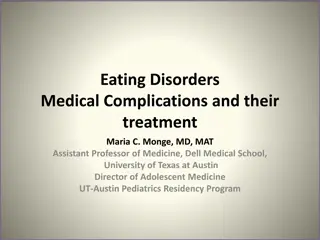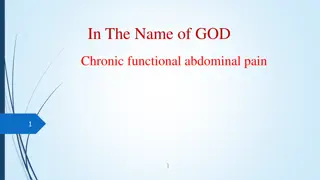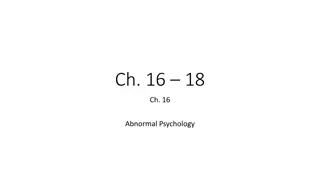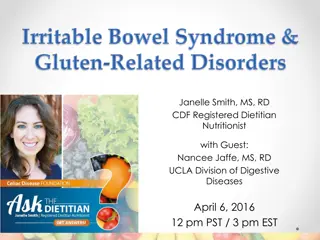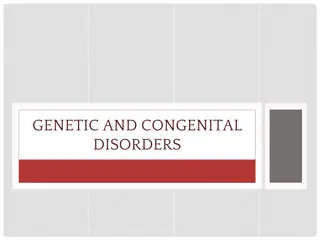Understanding Functional GI Disorders: A Comprehensive Overview
Functional GI disorders encompass a range of conditions affecting the gastrointestinal system, such as irritable bowel syndrome and disorders of the gut-brain interaction. These disorders are characterized by no structural abnormalities but are influenced by factors like motility disturbance, visceral hypersensitivity, altered gut microbiota, and more. They account for a significant portion of GI problems seen by doctors, with goals of accurate diagnosis, early detection of underlying diseases, and cost minimization in managing these conditions. Various disorders affecting the esophagus, gastroduodenal region, bowels, and anorectal area are discussed, shedding light on the complexities and prevalence of these conditions. Factors influencing these disorders include GI motility, visceral hypersensitivity, intestinal inflammation, and genetic and psychosocial factors. The summary highlights common symptoms, diagnostic approaches, and the intricate interplay between the brain and the gut in these conditions.
- Functional GI Disorders
- Irritable Bowel Syndrome
- Gut-Brain Interaction
- Gastrointestinal Health
- Digestive System
Download Presentation

Please find below an Image/Link to download the presentation.
The content on the website is provided AS IS for your information and personal use only. It may not be sold, licensed, or shared on other websites without obtaining consent from the author. Download presentation by click this link. If you encounter any issues during the download, it is possible that the publisher has removed the file from their server.
E N D
Presentation Transcript
What are functional GI disorders? Irritable bowel syndrome Cases of various other functional GI disorders Questions
Disorders of the gut-brain interaction. No structural abnormalities. Caused by a motility disturbance, visceral hypersensitivity, altered gut microbiota, altered mucosal immune function, altered CNS processing.
Esophageal: Globus, functional heartburn, reflux hypersensitivity. Gastroduodenal: Functional dyspepsia, belching, rumination Bowel disorders: IBS with bloating, constipation, or diarrhea predominance, opioid induced constipation Gallbladder or sphincter of Oddi disorders Anorectal: Proctalgia fugax, levator ani syndrome, functional defecation disorders
1 in 4 people in the US have one of these disorders. Accounts for 40% of GI problems seen by doctors. Goals Make a diagnosis Don t miss an underlying structural disease Minimize cost
GI motility Visceral hypersensitivity Intestinal inflammation Post-infectious Alteration in fecal microflora Food sensitivity Genetics Psychosocial dysfunction
Increased frequency and irregularity of luminal contractions Prolonged transit time (IBS-C) Exaggerated motor response to meal ingestion (IBS-D)
Awareness and pain caused by balloon distention in the intestine occurs at lower balloon sizes in patients with IBS Patients who complain of bloating and gas actually had similar volumes of gas compared to controls. Where is this heightened sensitivity Local GI nervous system Central modulation from the brain Specific GI mediators (serotonin, kinins) Spinal cord activation of NMDA receptors Highly complex brain-gut interaction
Increased lymphocytes, mast cells, and proinflammatory cytokines have been found in the GI tract in patients with IBS. Risk of IBS increased 6-fold after an acute gastroenteritis Bile salt malaborption Increased inflammatory cells Antibiotic use
Fecal microbiota in IBS different from healthy controls Visceral hypersensitivity can be induced in germ- free animals by innoculating their GI tract with stool from IBS patients and not from controls. Patients with IBS have more frequent positive hydrogen breath tests Xifaxan can give prolonged relief of IBS symptoms. Stool transplant has not been consistently shown to be beneficial in IBS.
Genetics (No identified gene as of yet) Psychosocial factors Patients with IBS report more stressful events and have higher anxiety, depression, phobias, somatization Brain corticotrophin releasing factor over activity contributes to anxeity and depression. IV CRF leads to increased abdominal pain and colonic motility in IBS patients compared to controls. Food intolerance Poor correlation between skin prick testing and symptom exacerbation Low FODMAP diets, gluten-free diets can decrease symptoms
Rome IV criteria: Recurrent abdominal pain at least 1 day per week in the last 3 months associated with 2 or more of the following Related to defecation Associated with a change in stool frequency Associated with a change in stool form
55 year old with a history of diabetes who presents with 3 months of abdominal discomfort, loose stool, and weight loss. Moving bowels does give some relief with the discomfort. No blood in the stool. No nocturnal symptoms. No fecal incontinence. Underwent colonoscopy with colon biopsies that were normal. What is next step?
CBC Tissue transglutaminase IgA and total IgA If IgA deficient then TTG IgG or deamidated gliadin antibodies Stool leukocytes or stool calprotectin Giardia stool antigen Consideration of a trial of a bile acid binder (colestipol or cholestyramine)
Age of onset >50 Rectal bleeding or melena Nocturnal diarrhea Progressive abdominal pain Unexplained weight loss Iron deficiency anemia Family history of IBD or colorectal cancer
No alarm features This limited diagnostic approach rules out organic disease in over 95 percent of patients Alarm features Endoscopic evaluation with biopsies and consideration of CT if concern for structural lesion.
Therapeutic clinician-patient relationship Healthy living: exercise regularly, sleep hygeine Diet Food allergy testing not beneficial Avoid alcohol and caffeine Avoid Gas-producing foods Beans, onions, celery, carrots, raisins, bananas, apricots, prunes, wheat germ, pretzels, bagels Low FODMAP diet
FODMAPs are short chain carbohydrates that are poorly absorbed, osmotically active, and rapidly fermented leading to abdominal bloating and pain. Strict diet for 6-8 weeks then re-introduce foods one at a time to see what is tolerable. Importance of a dietician Non-celiac gluten sensitivity (Benefit may be related to a low fructan diet rather than a low gluten diet).
Proteins: beef, chicken, eggs, fish, lamb, pork, prawns, tempeh, and tofu Whole grains and starches: white and brown rice, lentils, corn, oats, quinoa, cassava, and potatoes Fruit: blueberries, raspberries, pineapple, honeydew melon, cantaloupe, kiwi, limes, guava, starfruit, grapes, and strawberries Vegetables: bean sprouts, bell peppers, bok choy, radishes, carrots, celery, eggplant, kale, tomatoes, spinach, cucumber, pumpkin, and zucchini Nuts: almonds (no more than 10 per sitting), macadamia nuts, peanuts, pecans, pine nuts, and walnuts Seeds: pumpkin, sesame, and sunflower seeds, as well as linseeds Dairy: lactose-free milk, Greek yogurt, and Parmesan, Colby, cheddar, and mozzarella cheeses Oils: coconut and olive oils Beverages: peppermint tea and water Condiments: cumin, saffron, cinnamon, paprika, coriander, cardamom, soy sauce, fish sauce, some chile-based products, ginger, mustard, pepper, salt, white rice vinegar, and wasabi powder
Anti-diarrheals: Loperamide (inhibits peristalsis, decreasing diarrhea but not pain/bloating) Bile acid sequestrants (colestipol/cholesytramine) Eluxadoline (Viberzi): Mu opioid receptor agonist and delta-opioid receptor antagonist. Contraindications: biliary disorders, prior cholecystectomy, pancreatitis, Child's C cirrhosis, heavy alcohol. 5HT-3 receptor antagonists: Alosetron (young females who have failed 6 months of standard therapy). Can cause severe constipation and ischemic colitis.
Anti-spasmodics Dicyclomine/Hyoscyamine: Anti-cholinergic activity that inhibits GI smooth muscle Peppermint oil inhibits GI smooth muscle Antibiotics: Rifaximin Tricyclic anti-depressant Analgesic effects Anti-cholinergic effects on smooth muscle.
Psyllium (start slow once daily and can increase gradually) Osmotic laxatives non-absorbable sugar brings water into the GI tract Polyethylene glycol (Miralax) Lactulose Linaclotide (linzess) and plecanatide (trulance): Guanylate cyclase C agonists increasing cGMP stimulating intestinal fluid secretion and transit. Lubiprostone (amitiza): Chloride channel activator enhancing intestinal fluid secretion. Tegaserod (Zelnorm) 5-HT4 agonist: stimulates peristalsis and intestinal secretion Taken off market for increased risk of MI or stroke Avoid use if more than one cardiac risk factor. Avoid with history of ischemic colitis, bowel obstruction, symptomatic gallbladder disease, or sphincter of oddi
I use when patients have failed medical therapy or give a history of manipulative movements to help move bowels. If anorectal dyssynergia identified, can treat with biofeedback therapy with excellent response
Data limited by short-term data, small effect size of probiotics Align (Bifidobaterium infantis 35624) Significant benefit in 362 patients with IBS (but only at 1 dose and no dose-response relationship). Another study in 77 patients showed B. infantis led to improvement in symptoms and normalization of IL-10/IL-12 ratio
69 patients who underwent a brief psycho- educational group intervention had clinically meaningful improvement in symptoms and quality of life.
55 year old with a history of diabetes who presents with 3 months of abdominal discomfort, loose stool, and weight loss. Moving bowels does give some relief with the discomfort but it doesn t go away. No blood in the stool. No nocturnal symptoms. No fecal incontinence. Underwent colonoscopy with colon biopsies that was normal.
28 year old female with obsessive compulsive, depression, anxiety, and fibromyalgia presents with several years of vomiting. She has seen multiple providers and has had a CT and an EGD that did not show a cause. She says she will eat and within 10 minutes, the food will come back up into her mouth and she will have to spit it out. No associated weight loss.
Physiology: post-prandial raised intra- abdominal pressure with negative intrathoracic pressure leads to effortless regurgitation of food into the mouth. 0.8 to 0.9% of adults in the population (up to 8% of patients with fibromyalgia or eating disorders).
Diagnosis: EGD and CT to rule out obstruction. Impedance manometry shows reflux to the proximal esophagus after an increase in gastric pressure to >30mmHg. Treatment Reassurance and education Treat underlying depression/anxiety Diaphragmatic breathing
42 year old female presents with recurrent episodes of severe anorectal pain that will last several minutes and goes away on its own. Has no pain whatsoever when not having an attack. Gets on average 1 attack per month. No clear trigger for the pain. Has had symptoms for 3 years. Colonoscopy was normal. Pelvic ultrasound normal.
Different from levator ani syndrome where patients get a chronic dull ache or pressure high in the rectum worse with sitting. On exam, tenderness can be elicited with traction of the puborectalis. Treatment: Typically just reassurance If symptoms are severe or frequent, sitz baths and topical nitroglycerin or diltiazem. Inhaled albuterol has also been shown to shorten duration of symptoms. If no benefit then biofeedback therapy
38 year old female with prior cholecystectomy presents with recurrent squeezing abdominal pain in the RUQ that lasts 45 minutes sometimes and other times up to 2 hours. No change in pain with bowel movements. No pain in between episodes. Gets symptoms several times per month. No change in pain with bowel movements and no diarrhea or constipation. Has been treated with levsin and pantoprazole without benefit. She has gone to the Emergency Department twice for attacks and both times her AST and ALT rose to 3 times the upper limit of normal and then were normal when rechecked when pain was gone. Ultrasound shows prior cholecystectomy. Bile duct was normal. MRCP also showed a normal bile duct without stones.
More common in females Frequently after cholecystectomy (gallbladder may serve as a reservoir to accommodate increased pressure or nerve damage during cholecystectomy could lead to sphincter spasm). Diagnosis: Epigastric or RUQ pain, 30 minutes or longer in duration, recurrent symptoms at different intervals (not daily), pain builds up to a steady level, pain is severe, pain unrelated to bowel movements, acid suppression, or postural changes.
Abnormal liver enzymes and dilated bile duct ERCP with sphincterotomy (papillary stenosis) Either abnormal liver enzymes or a dilated bile duct ERCP with sphincter of oddi manometry and sphincterotomy if elevated pressures Neither abnormal liver enzymes or a dilated bile duct Avoid ERCP
32 year old female presents with 6 months of a feeling of a lump in the anterior midline of the neck. Feels like something is stuck. Constant symptoms, worse with stress, no associated dysphagia or odynophagia. No weight loss.
22% lifetime risk, 4% of ENT visits. Initial evaluation H&P for alarm symptoms (pain, lateralization of symptoms, dysphagia, odynophagia, weight loss, voice change, lymphadenopathy). Treatment: reassurance, twice daily proton pump inhibitor for 6-8 weeks. If no improvement then EGD, esophogram vs. impedance manometry and 24 hour pH study. Other treatment options Tricyclic antidepressants, gabapentin, ablation of an inlet patch
Drossman DA, et al. Rome IV, the functional gastrointestinal disorders Gastroenterology 2016;150:12621279. Talley NJ. Functional gastrointestinal disorders as a public health problem. Neurogastroenterol Motil. 2008 May;20 Suppl 1:121-129. Smalley W et al. American gastroenterological Association (AGA): Clinical practice guidelines on the laboratory evaluation of functional diarrhea and diarrhea-predominant irritable bowel syndrome in adults (IBS-D). 2019 Brandt LJ, et al. An evidence-based position statement on the management of irritable bowel syndrome. American College of Gastroenterology Task Force on Irritable Bowel Syndrome. Am J Gastroenterol. 2009;104 Suppl 1:S1. Schmulson MW, Chang L. Diagnostic approach to the patient with irritable bowel syndrome. Am J Med.1999;107(5A):20S. Skodje GI, et al. Fructan, rather than gluten, induces symptoms in patients with self-reported non-celiac gluten sensitivity. Gastroenterology. 2018;154(3):529. Tang B et al, Epidemiology of globus symptoms and associated psychological factors in China. J Dig Dis. 2016;17(5):319. Whitehead WE et al. Tolerance for rectosigmoid distention in irritable bowel syndrome. Gastroenterology 1990;98:1187. Serra J et al. Impaired transit and tolerance of intestinal gas in the irritable bowel syndrome. Gut 2001;48:14. Willert RP et al. The development and maintenance of human visceral pain hypersensitivity is dependent on the N- methyl-D-aspartate receptor. Gastroenterology.2004;126:683. Tornblom H et al. Full thickness biopsy of the jejunum reveals inflammation and enteric neuropathy in irritable bowel syndrome. Gastroenterology 2002;123:1972. Barbara G, et al. Activated mast cells in proximity to colonic nerves correlate with abdominal pain in irritable bowel syndrome. Gastroenterology 2004;126:693. Zanini B et al. Incidence of post-infectious irritable bowel syndrome and functional intestinal disorders following a water-borne viral gastroenteritis outbreak. Am J Gastroenterol 2012;107:891. Labus J, et al. Randomised clinical trial: symptoms of the irritable bowel syndrome are improved by psychoeducation group intervention. Aliment Pharmacol Ther. 2013 Feb;37(3):304-15.













